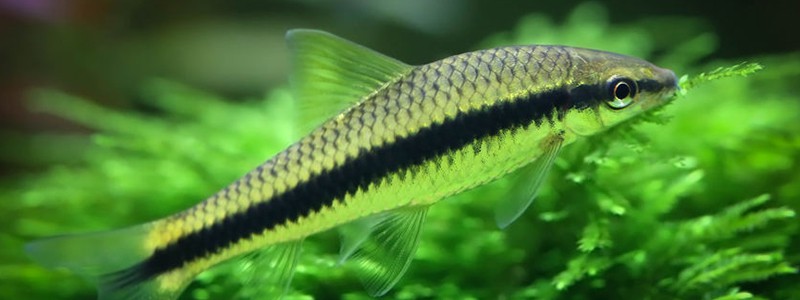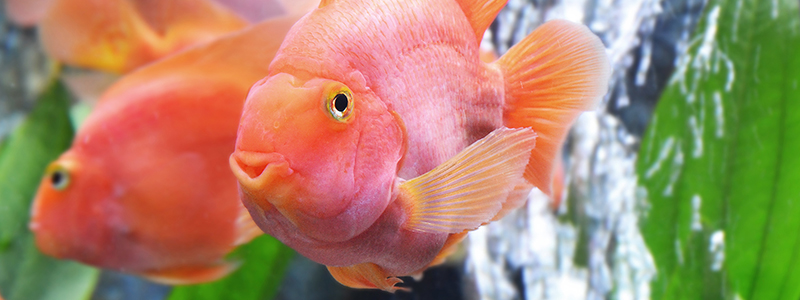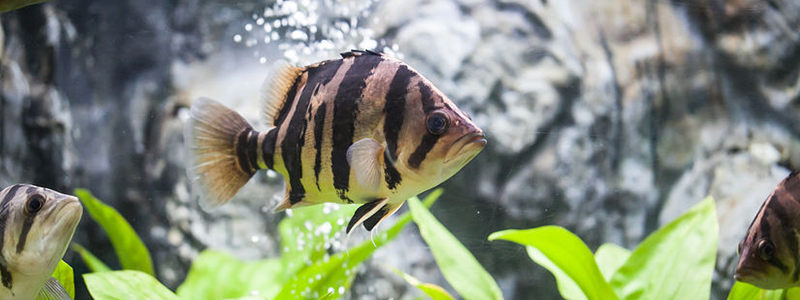Quick Stats
- Family: Cyprinidae
- Scientific Name: Crossocheilus oblongus
- Care level: Easy
- Temperament: Peaceful
- Diet: Omnivorous, Bottom Feeder
- Water conditions: Freshwater, 24 – 26 degrees Celsius (75 – 79F), 6.5 – 8 pH
- Max Size: 15 centimeters (6 inches)
- Minimum tank size (as an adult): 115 Liters (30 gallons)
Brief Overview: Siamese Algae Eater Fish Care
Siamese Algae Eaters are tropical freshwater fish closely related to the carp. These bottom-dwellers are native to streams, rivers, and flooded forests of Southeast Asia, including the Chao Phraya and Mekong Basins and the Malay Peninsula.
They are a popular addition to a community tank because they are peaceful but also because they can help manage algae levels. Unlike other algae eaters, the Siamese Algae Eater is active, providing interesting movement as well as covering the entire tank quickly. This fish is also easy to keep and makes an excellent choice for an inexperienced aquarist.
The Siamese Algae Eater Fish has a long, thin shape with gold/grey coloration and a black horizontal stripe running its length. This stripe can fade to allow the fish to camouflage better with its environment. A true Siamese Algae Eater has no maxillary barbels but has a deeply fringed upper lip in a “V” shape.
Red Algae-Eaters (Crossocheilus langei) are often sold under the same name. Red Algae-Eaters have a bright brownish body with a prominent brown/black horizontal stripe, small maxillary barbels, and an infringed upper lip. Other similar-looking species include the Flying Fox (Epalzeorhynchos kalopterus) and False Siamensis (Garra cambodgiensis). Flying Fox Fish tend to be more aggressive than the Siamese Algae Eater and less effective at consuming tank algae. Flying Foxes also exhibit a horizontal black stripe but can be differentiated because their stripe ends where their tail fin begins.
Siamese Algae Eater Fish Lifespan
How Long Do Siamese Algae Eaters Live For?
Siamese Algae Eaters have a life expectancy of up to 10 years in an aquarium with excellent care and conditions.
How fast/slow should you expect your Siamese Algae Eater to grow?
Siamese Algae eaters grow slowly, eventually reaching up to 15 centimeters (6 inches) in length.
What’s Siamese Algae Eater Fish max size?
The maximum size of a true Siamese Algae Eater is 15 centimeters (6 inches).
Different types of Algae Eater Fish
Here are some other Algae Eater Fish popular among fish keepers:
Chinese Algae Eater: Though cheap and readily available in fish stores, Chinese Algae Eaters are a poor choice for a community tank. Voracious algae eaters as juveniles, this fish will begin to feed on the flesh of other fish as they mature and can become aggressive and territorial.
Plecostomus: A great addition to almost any aquarium, this species of pleco only grows to about 10 centimeters (4 inches) long. They can exhibit striking gold and albino colorations.
Twig Catfish: Twig Catfish readily accept a variety of food and can quickly clear a tank of green algae. They are a bit more difficult to care for than other algae eaters, requiring pristine water conditions, a current, and high oxygen levels.
Otocinclus Catfish: Also known as the Dwarf Sucker, this catfish rarely grows larger than 5 centimeters (2 inches) long. They feed on brown and soft green algae but have a large appetite and will feed on live plants or offered vegetables if algae are not abundant enough. This species is a schooling fish and should be kept in groups of 5 or more.
Siamese Algae Eater Fish Diet & Feeding

As their name suggests, Siamese Algae Eaters feed on algae on the surfaces of their tanks.
What do Siamese Algae Eater Fish eat in the wild?
Siamese Algae Eaters are native to creeks and streams in Southeast Asia where they feed on algae, vegetation, and other plant matter the majority of the time. This fish is an omnivore through and will scavenge dead fish and insects if given the opportunity.
What foods are recommended for Siamese Algae Eater Fish?
In an aquarium setting, Siamese Algae Eaters will eat almost anything you put in the tank. This includes flake food, algae wafers, and live or frozen foods such as brine shrimp and blood worms.
Siamese Algae Eater Fish Feeding habits
Avoiding overfeeding your Siamese Algae Eater is important if you want their help controlling algae levels in your aquarium; these fish may stop eating algae in favor of the other food sources you provide. Do not feed your fish more than they can consume in 2 or 3 minutes, and if you see algae levels start to increase, feed less. Conversely, if you believe your algae eaters are not getting enough nutrients, consider a sinking pellet food that will easily find these bottom-dwellers.
Siamese Algae Eater Fish Fish Tank Setup
Like all fish, Siamese Algae Eaters thrive best in a tank that resembles their natural habitat and suits their needs.
A brief overview of natural habitat
Siamese Algae Eaters are indigenous to the Chao Phraya and Mekong Basins, Thailand, and Cambodia. They are commonly found in fast-moving streams with a low pH and little hardness but are also known to inhabit flooded fields and forests during the rainy season. Their preferred habitat has a substrate of sand, pebbles, and boulders among tree roots and plentiful amounts of green algae, diatoms, and microorganisms on which to feed.
Siamese Algae Eaters Fish Tank size
Tank size requirements for Siamese Algae Eaters are 115 liters (30 gallons) minimum. Larger tanks offer a more stable environment, are less prone to sudden changes, and are an overall better choice for your fish.
Siamese Algae Eater Fish Water Conditions
Siamese Algae Eaters can be housed in a typical community tank, but an aquarium with a water flow resembling a tropical stream is ideal.
Aquarists recommend keeping Siamese Algae Eaters in high-quality water conditions similar to the pristine streams in which these fish are found in the wild. This species is intolerant of even low levels of ammonia or nitrite, so a highly-efficient filter and close water monitoring are essential.
Other than clean water, Siamese Algae Eaters can be kept in a wide variety of water conditions. Tolerant to a broad pH range, this fish is ideally kept in slightly acidic water between 6.5 and 7.5 in a temperature range of 24 to 26 degrees Celsius (75 – 79 degrees Fahrenheit).
Tank Decorations
Siamese Algae Eaters prefer a combination of sand, pebbles, larger rocks, and driftwood along the tank bottom, creating a labyrinth of nooks and crannies for the fish to explore and find cover. Live plants provide ideal feeding areas as they become coated with bacteria and algae the fish can feed on. Bolbitis and Anubias are excellent plant choices for this fish, but beware that Algae Eaters will begin to eat live (and plastic) plants if sufficient food cannot be found.
Siamese Algae Eaters are quick and active swimmers, so keep a lid on your tank to avoid your fish accidentally jumping out.
Siamese Algae Eater Fish Tank Mates
Siamese Algae Eaters are generally peaceful and social by nature. This fish makes a fantastic addition to a community tank as long as other fish are close to the same size and equally peaceful. This fish can be kept singly, in pairs, or even in groups of 4-6. Some Siamese Algae Eaters may nip the fins of long-finned fish species.
Any peaceful community fish will get along well with Siamese Algae Eaters so the list of suitable tankmates is long. Some possible additions are:
Species of shrimp and snails are also popular options for tankmates.
Siamese Algae Eater Fish General Behavior
Siamese Algae Eaters are genial fish, making them great choices for a community tank of other amicable fish. This species spends most of its time in the bottom of the tank where they swim around until they find an algae-covered area and remain until the algae have been consumed.
If you keep multiple Algae Eaters together you will often find them feeding in groups. This species is rarely aggressive but very energetic. Though unaggressive, their quick swimming might disturb other, calmer fish species in your tank.

How to Keep Siamese Algae Eater Fish Healthy
There are no specific diseases that Siamese Algae Eaters are prone to, but this species is susceptible to typical ailments that affect freshwater fish.
Common diseases to look out for
Like most aquarium fish, Siamese Algae Eaters are susceptible to ich, a disease caused by protozoa. Symptoms of ich include twitching, rubbing their bodies on various surfaces in the tank, and the appearance of white spots on the body and gills. They usually respond well to medication and heal quickly.
Siamese Algae Eaters can be affected by skin flukes and other parasites, fungal infections, and bacterial infections.
When treating an individual fish, best practice calls for removing the fish to a separate “hospital tank” devoid of plants or gravel for treatment. If a disease has affected an entire tank, it is probably best to treat the tank. Read and follow the instructions for any medication or treatment for best results. Take care, as some treatments can destroy beneficial bacteria or otherwise adversely affect water quality. The carbon in your filtration system may absorb some medications, rendering treatment ineffective, and may need to be removed.
Know the signs and treatments of common freshwater fish diseases to catch problems early and keep your Siamese Algae Eaters happy and healthy.
Tips on keeping Siamese Algae Eater Fish in good health
Siamese Algae Eaters are typically easy to keep healthy as long as you monitor and maintain your water composition. Perform water changes every 2 weeks and test water quality regularly to keep ammonium and nitrite levels in check, and do not overfeed as food waste will cause these levels to spike.
High-quality foods are less likely to cause organ issues and constipation than cheaper foods. Keep in mind that parasites and bacteria can be introduced by new tankmates as well as live food, plants, and tank decorations.
Breeding Siamese Algae Eaters
Siamese Algae Eaters are typically only bred on farms with the aid of hormones, so successful breeding is unlikely to occur in your aquarium. Simply sexing individuals is challenging, with females only identifiable by an approximate 30% larger size, and little is known about the ideal spawning conditions for this species.
Interesting Facts About Siamese Algae Eater Fish
- Siamese Algae Eaters are rarely sold in stores, with most stores selling other species under this name
- This species is arguably the most efficient algae cleaner for an aquarium
- Siamese Algae Eaters are closely related to the carp
Is a Siamese Algae Eater right for you?
Whether you are new to fish keeping or an experienced aquarist, keeping a Siamese Algae Eater happy and healthy is relatively easy. Their peaceful and hardy nature makes them better able to weather the mistakes of a beginner and help in keeping your tank algae-free. Simply maintain your tank with other peaceful fish, plenty of plants and places to hide, and adequate free space to swim and your community tank will thrive.




